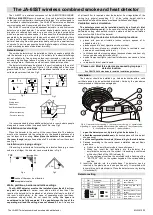
NB-IoT Signaling
R&S
®
CMW-KM300/-KS300
16
User Manual 1178.5689.02 ─ 06
2.2.3.1
Fading Simulator
Multi-path fading is an effect which occurs in real world situations. A signal sent from
the base station follows the direct line of sight and/or takes routes with reflections. The
phase-shifted signals sum up at the receiving antenna. If the receiver is moving, there
are also frequency-shifted signals.
The internal fading simulator supports multipath propagation conditions defined in
annex B.2 of 3GPP TS 36.101.
A faded signal has a higher crest factor than an unfaded one. To avoid distortion, the
baseband signal must be attenuated before entering the fading module. The necessary
attenuation (insertion loss) depends on the selected fading profile.
In NB-IoT signaling, the insertion loss at the baseband level can be calculated auto-
matically or set manually. It is automatically compensated on the HF level. The com-
pensation implies a shift of the allowed DL power range to the same extent, but in
opposite direction.
2.2.3.2
AWGN Generator
Additional white Gaussian noise (AWGN) is typically modeled in receiver tests,
because it can lead to a decrease of throughput. The quality of the received signal is
affected by the ratio of the signal power to the surrounding traffic noise level (signal to
noise ratio). The modulated signals from neighbor cells simply appear as noise. This
effect is simulated by adding AWGN to the signal.
The internal fading module supports AWGN insertion with configurable bandwidth and
signal to noise ratio. Insertion loss at the baseband level is calculated and compensa-
ted automatically at the HF.
AWGN insertion via the signaling unit is disabled for fading scenarios (see
2.2.4
Connection States
An NB-IoT connection is always a packet-switched connection. The main connection
states are described in the following table. The states are displayed in the main view
as "Packet Switched" (PS) state.
PS state
Description
"(Cell) Off"
No downlink signal transmission
"(Cell) On"
The R&S
CMW emulates an NB-IoT cell, transmitting an NB-IoT signal to which the UE
can synchronize. After synchronization, the UE can initiate an attach towards the instru-
ment.
General Description
深圳德标仪器
135-1095-0799
















































